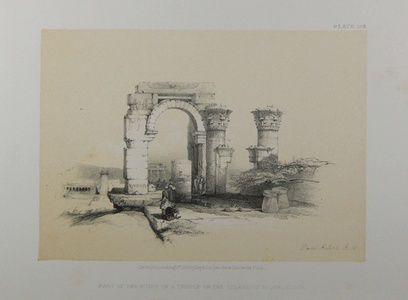| Method | Lithograph with tint stone |
| Artist | after David Roberts |
| Published | London, Published Augt. 1st. 1856, by Day & Son, Gate Street, Lincoln's Inn Fields |
| Dimensions | Image 124 x 175 mm, Sheet 195 x 287 mm |
| Notes |
Plate 183 from Volume 5 of the small format reprint of Roberts' The Holy Land, Syria, Idumea, Arabia, Egypt & Nubia. A view of the Roman arch on the small island of Bigeh, near the temple complex of the neighbouring island of Philae, in the ancient Egyptian region of Nubia. Bigeh, owing to its proximity to the largest cult sites of Philae, shared in the area's importance as a centre of Osiris worship, and is one of a number of locations claimed as the burial place of the god. Bigeh was also likely the location of a temple to the god Thoth, whose epithets include 'Great and Splendid God in Bigeh.' The settlement on the island was enlarged in the Roman era, and the ruins of a triple-arched monumental Roman gateway is one of the few extant remains on the island. Unlike Philae, the ruins of Bigeh were unaffected by the flooding of Lake Nasser by the Aswan Dam project, owing to their location on the highest outcrop of rock on the island. Roberts' view depicts a group of men in Arab dress resting in the shade under the remaining central arch of the Roman gateway. The gateway is topped with a relief carving of a winged sun-disk, and flanked by wide lotus-headed columns. In the distance, the monuments of Philae can be seen, including the Hypaethral Kiosk of Trajan and parts of the Temple of Isis. David Roberts RA (24th October 1796 – 25th November 1864) was a Scottish painter. He is especially known for a prolific series of detailed prints of Egypt and the Near East produced during the 1840s from sketches made during long tours of the region (1838-1840). This work, and his large oil paintings of similar subjects, made him a prominent Orientalist painter. He was elected as a Royal Academician in 1841. The firm of Day & Haghe was one of the most prominent lithographic companies of the nineteenth-century. They were also amongst the foremost pioneers in the evolution of chromolithography. The firm was established in 1823 by William Day, but did not trade under the moniker of Day & Haghe until the arrival of Louis Haghe in 1831. In 1838, Day & Haghe were appointed as Lithographers to the Queen. However, and perhaps owing to the fact that there was never a formal partnership between the two, Haghe left the firm in the 1850's to devote himself to watercolour painting. The firm continued as Day & Son under the guidance of William Day the younger (1823 - 1906) but, as a result of a scandal involving Lajos Kossuth, was forced into liquidation in 1867. Vincent Brookes bought the company in the same year, and would produce the caricatures for Gibson Bowles' Vanity Fair magazine, as well as the illustrations for Cassells's Poultry Book, amongst other commissions. Condition: Light foxing to margins, not affecting image. |
| Framing | unmounted |
| Price | £30.00 |
| Stock ID | 39170 |

